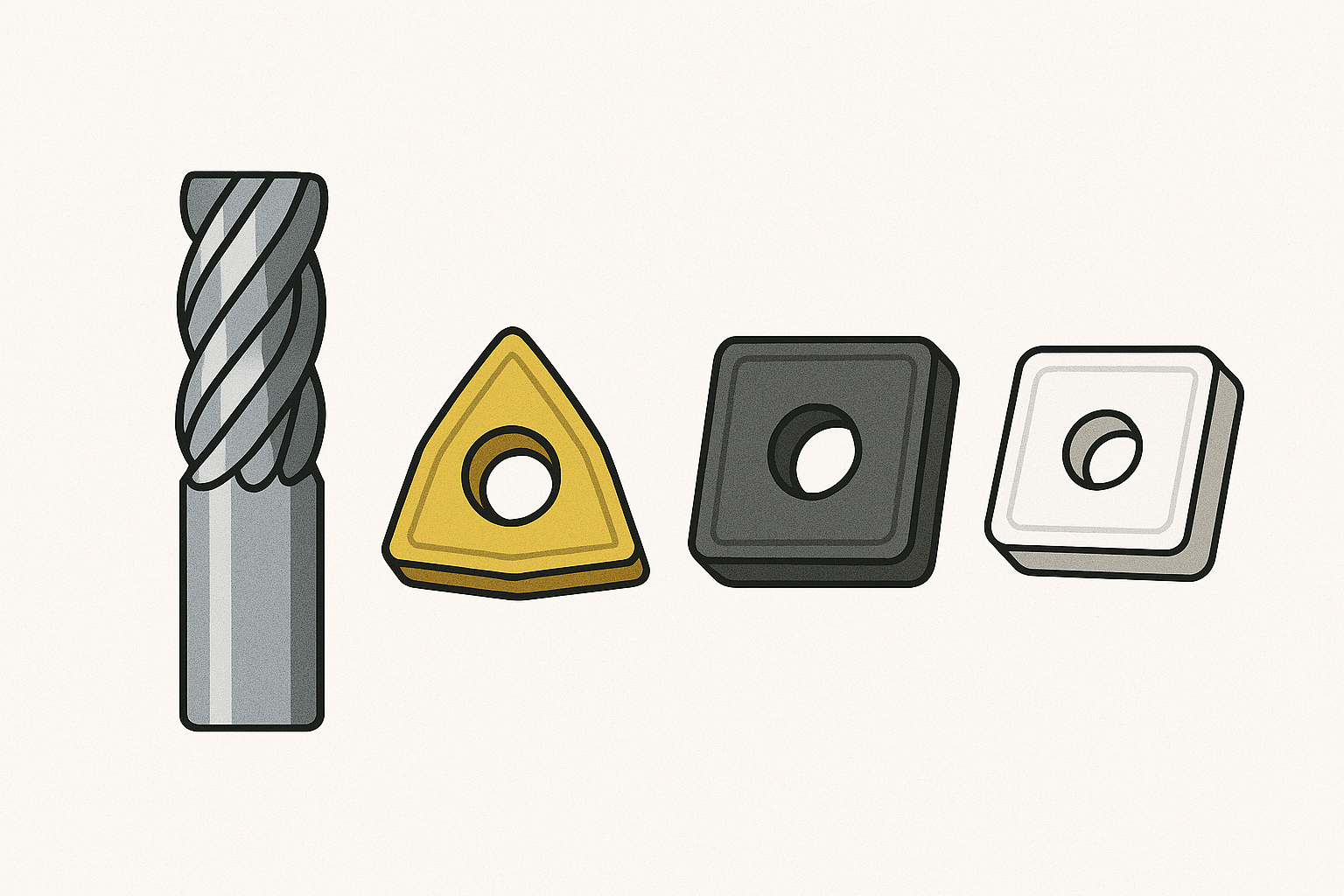T: 905-664-8661
info@cuttingtoolpickers.com

Comparative Analysis of Cutting Tool Materials: HSS vs Carbide vs Cermet vs Ceramic
When it comes to precision machining and high-performance cutting, choosing the right tool material can make or break your production process. From tool life and surface finish to cutting speed and cost-efficiency, every aspect is influenced by the composition of the cutting tool you're using.
In this blog post, we dive deep into the four most common cutting tool materials — High-Speed Steel (HSS), Carbide, Cermet, and Ceramic — to help machinists, engineers, and buyers make informed decisions.
🔧 1. High-Speed Steel (HSS): The Time-Tested Workhorse
Overview: High-Speed Steel is an alloy steel known for its hardness, toughness, and resistance to high temperatures — characteristics that make it one of the most commonly used materials in general-purpose machining.
Key Features:
-
Excellent toughness (less likely to chip or fracture)
-
Cost-effective
-
Can be resharpened multiple times
-
Performs well at moderate cutting speeds
Ideal For:
-
Low to medium-speed machining
-
Small batch production
-
Manual machining or hobbyist projects
-
Machining mild steels, aluminum, and some stainless steels
Limitations:
-
Poor performance at high speeds
-
Shorter tool life compared to carbide or ceramics
-
Susceptible to wear when machining hard materials
Bottom Line:
Use HSS tools when cost is a concern and cutting conditions aren't too aggressive.
⚙️ 2. Tungsten Carbide: The Industry Standard for Performance
Overview: Carbide tools are made by combining tungsten with carbon to create a material that's significantly harder than steel. Most carbide tools are actually cemented carbide, where the tungsten carbide is bonded with a metal like cobalt for added strength.
Key Features:
-
High wear resistance
-
Retains hardness at elevated temperatures
-
Excellent surface finish
-
Much longer tool life than HSS
Ideal For:
-
High-speed machining
-
CNC and automated production environments
-
Harder materials like cast iron, titanium, and some tool steels
-
Continuous or semi-continuous cuts
Limitations:
-
More expensive than HSS
-
More brittle — prone to chipping if mishandled or used on interrupted cuts
-
Typically not resharpenable (depends on tool geometry)
Bottom Line:
If you're running CNC machines or high-volume production, carbide is likely your go-to.
🧪 3. Cermet: The Surface Finish Specialist
Overview: Cermets (ceramic + metal) combine ceramic materials with metallic binders. They are engineered for high-speed applications where surface finish and tight tolerances are critical.
Key Features:
-
Superior wear resistance
-
Excellent chemical stability (great for ferrous metals)
-
Minimal built-up edge
-
Ideal for finishing operations
Ideal For:
-
High-speed finishing of carbon and alloy steels
-
Applications where surface finish is paramount
-
Dry cutting operations
Limitations:
-
Poor toughness — not suitable for heavy roughing or interrupted cuts
-
Less versatile than carbide
-
Sensitive to thermal shock
Bottom Line:
Cermets are excellent finishing tools but require stable conditions and consistent cuts.
🔥 4. Ceramic: The Heat-Resistant Powerhouse
Overview: Ceramic cutting tools are made from aluminum oxide or silicon nitride. They are extremely hard and heat-resistant, often used in high-speed machining of hard materials.
Key Features:
-
Operate at cutting speeds 5–10x higher than carbide
-
Exceptional thermal resistance
-
Suitable for hardened steels, nickel-based alloys, and superalloys
Ideal For:
-
High-speed machining of hard materials
-
Interrupted cuts (with silicon nitride-based ceramics)
-
Dry cutting (no coolant needed)
Limitations:
-
Very brittle — prone to chipping or breaking under vibration
-
Requires rigid setups and stable tool paths
-
Higher upfront cost
Bottom Line:
Best suited for experienced users or specialized high-speed operations where productivity is the highest priority.
📊 Quick Comparison Table
| Property | HSS | Carbide | Cermet | Ceramic |
|---|---|---|---|---|
| Hardness | Low | High | Very High | Extreme |
| Toughness | High | Medium | Low | Very Low |
| Wear Resistance | Medium | High | High | Very High |
| Cutting Speed | Low | High | Very High | Extremely High |
| Cost | $ | $$ | $$$ | $$$$ |
| Applications | General-purpose | High-speed CNC | Finishing | Hardened materials |
| Coolant Use | Often | Optional | Usually dry | Dry cutting |
| Surface Finish | Good | Excellent | Excellent | Good |
🧠 Final Thoughts: Choosing the Right Tool for the Job
There's no one-size-fits-all when it comes to cutting tool materials. Your choice depends on several factors:
-
Material being machined
-
Required surface finish
-
Volume of production
-
Rigidity of your setup
-
Budget constraints
Quick Tips:
-
Stick with HSS for manual, low-speed work or tight budgets.
-
Upgrade to Carbide for CNC, precision, and higher productivity.
-
Use Cermets for finishing operations with minimal wear.
-
Go with Ceramics only if you're working with tough materials at extremely high speeds in stable conditions.
🛠️ Need Help Picking the Right Tool?
At Cutting Tool Pickers, we’re all about making your life easier — from education to selection. Our curated tool listings and blog guides take the guesswork out of cutting tool decisions.
Got a question? Shoot us an email at info@cuttingtoolpickers.com or call us 905-664-8661

Comments
Leave a comment